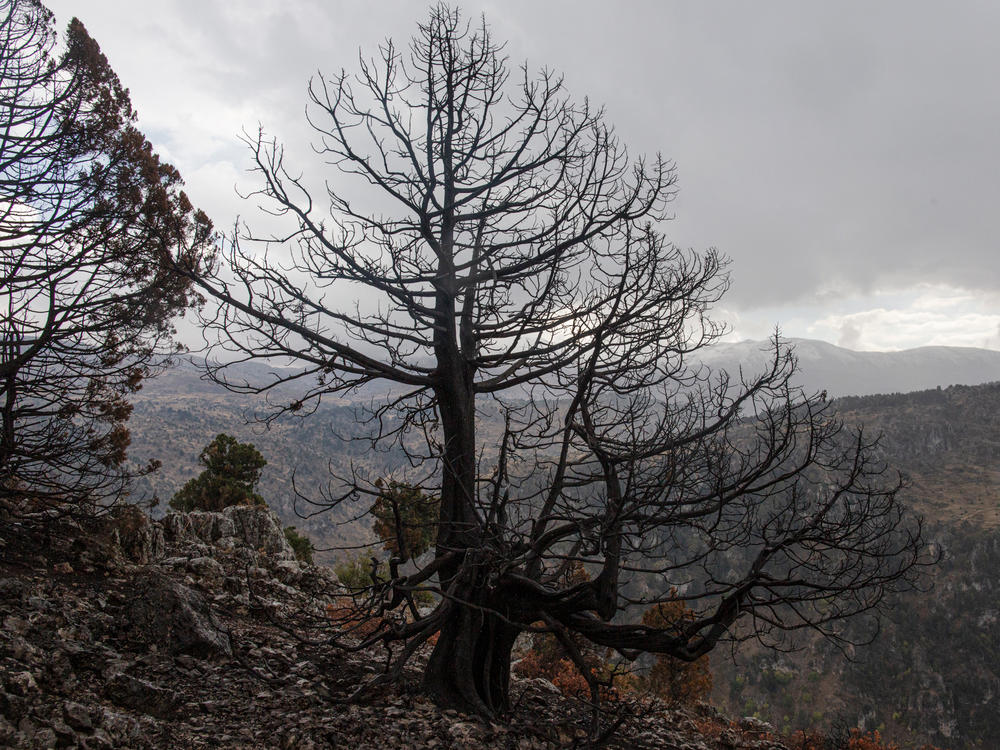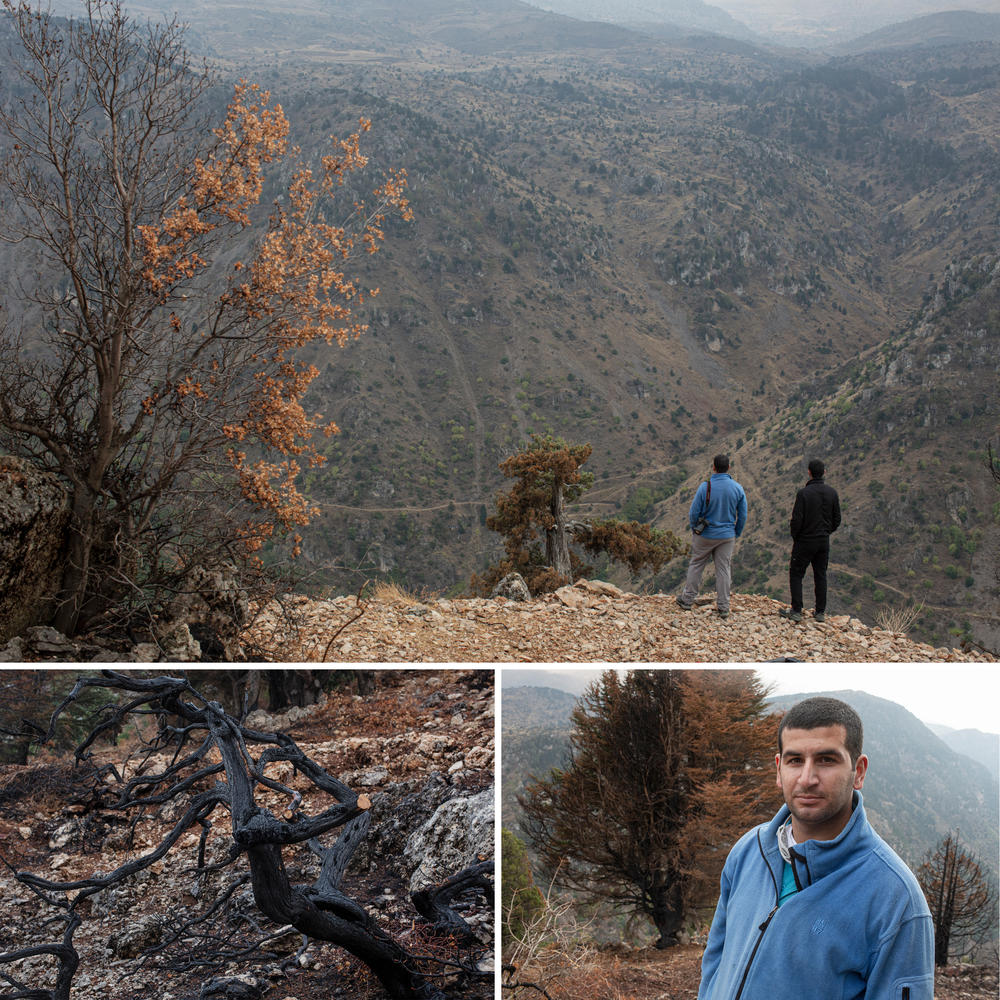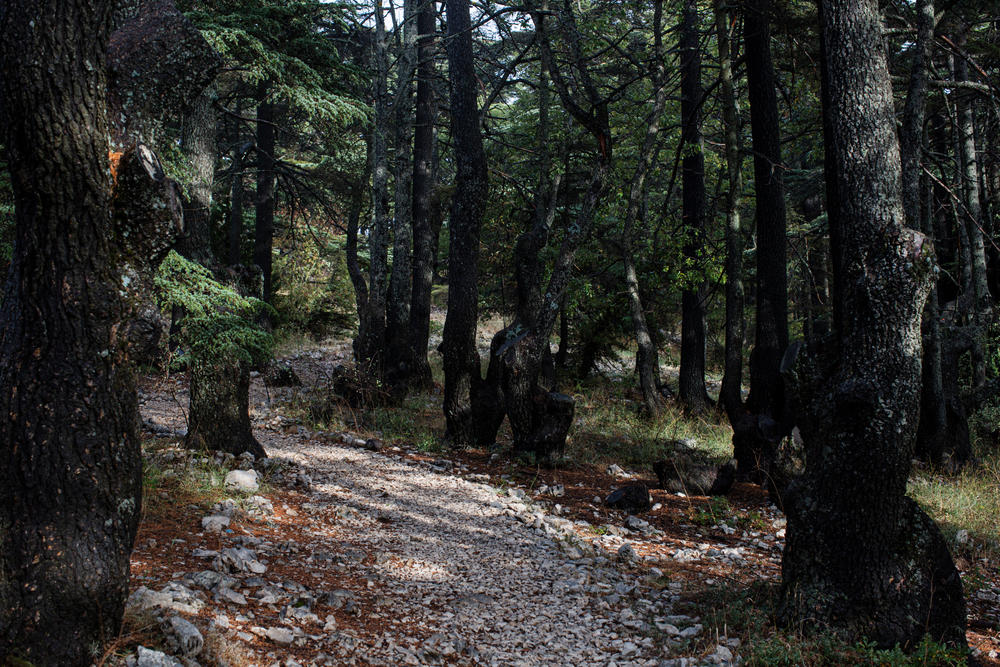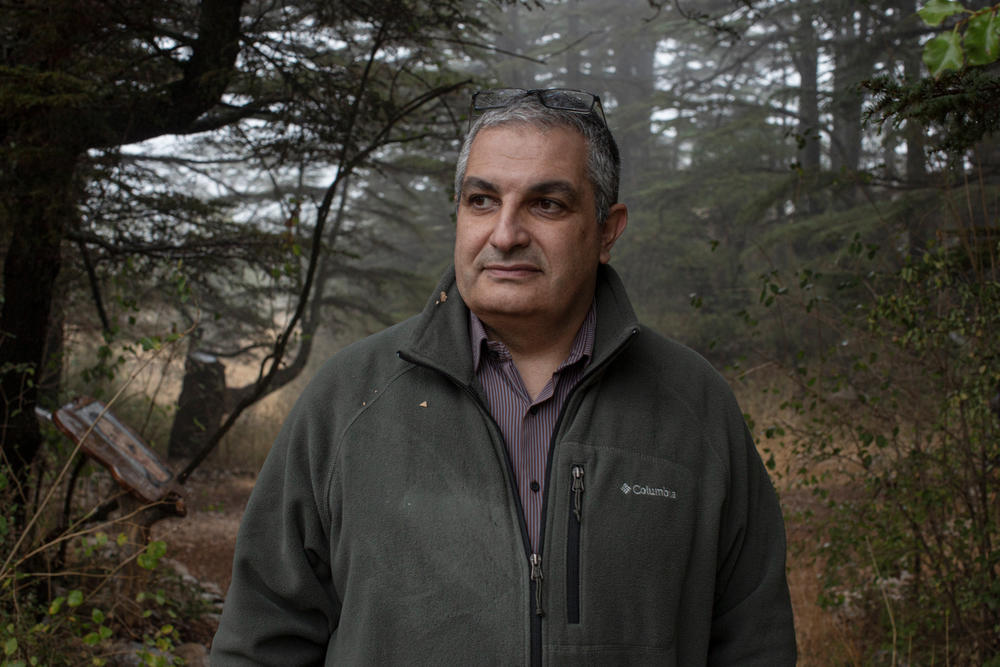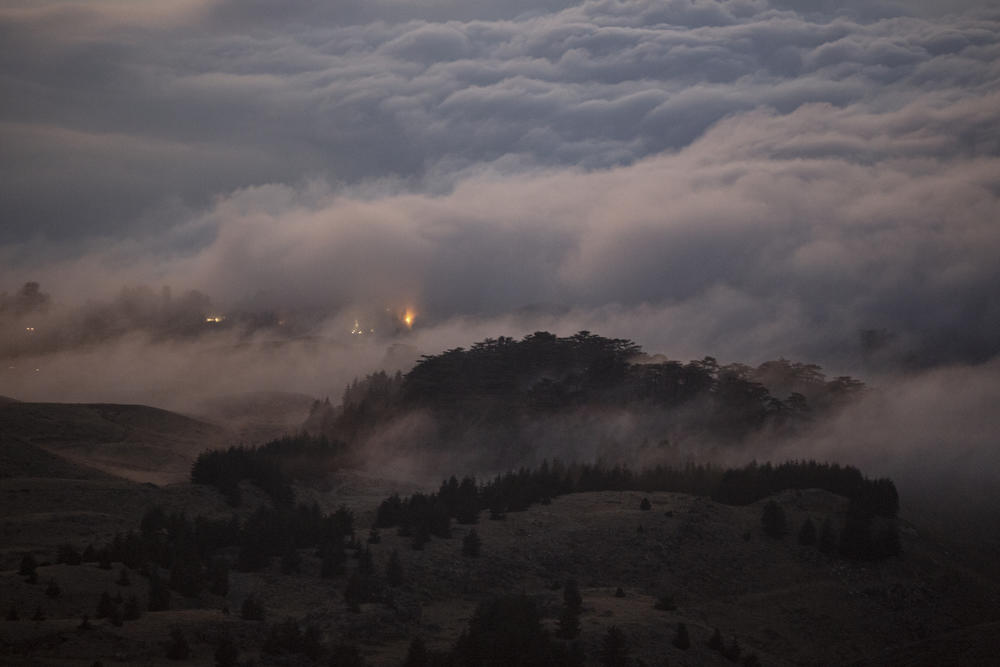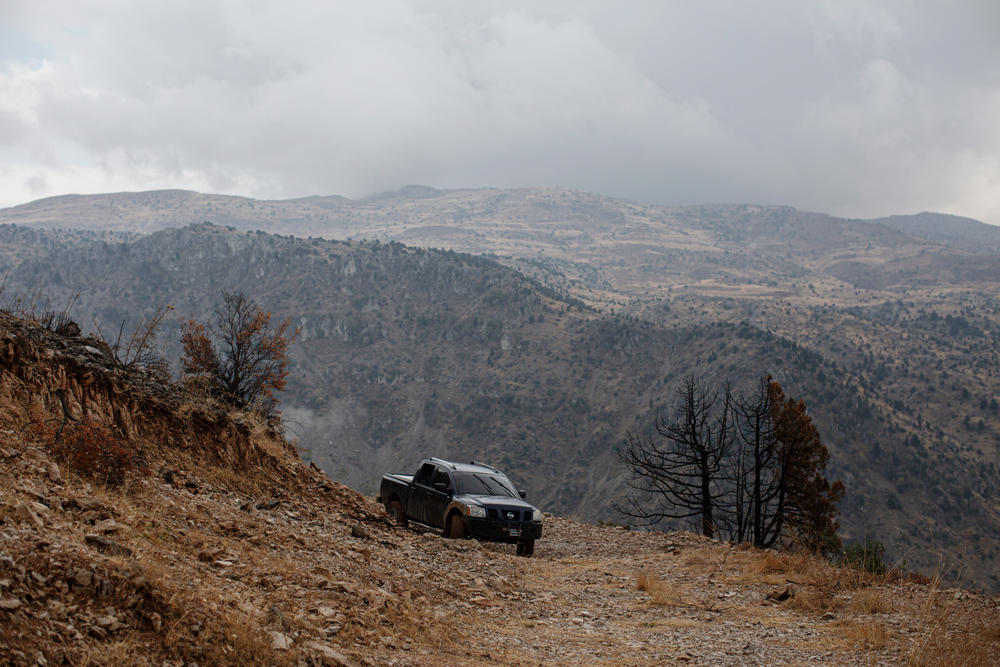Section Branding
Header Content
Climate Change Closes In On Lebanon's Iconic Cedar Trees
Primary Content
Khaled Taleb steps out of his vehicle high on a mountainside in northern Lebanon, and surveys the charred remains of the cedar forest he fought to save. A black carpet of the trees' burned needles crunches underfoot.
Armed with only gardening tools and cloth masks, Taleb and four friends spent the night of Aug. 23 on this mountainside battling a wildfire that swept up from the valley and engulfed this high-altitude woodland of cedars and juniper trees.
"The fear we felt for ourselves was nothing compared to the fear we had for the trees," recalls Taleb, who played under these boughs as a child, and who has worked for their protection since he was 16. Now 29, he runs an ecotourism and conservation group he founded called Akkar Trail.
The cedar tree is a source of national pride in Lebanon. Its distinctive silhouette of splayed branches graces the national flag. The forests here have furthered empires, providing Phoenicians with timber for their merchant ships, and early Egyptians with wood for elaborately carved sarcophagi.
But now the very survival of these ancient giants is in question. Scientists say rising temperatures and worsening drought conditions brought about by climate change are driving wildfires in this Middle Eastern country to ever higher altitudes, encroaching upon the mountains where the cedars grow.
Changing weather patterns in Lebanon, defined by its long Mediterranean coastline and mountain ranges, are also upsetting the ecology of the cedar forests. Warming temperatures have spawned infestations of the web-spinning sawfly, which has decimated entire tracts of forest.
Climate scientists predict average annual temperatures in the Middle East to increase by as much as 4 degrees Celsius by the end of the century, compared to the mid-1800s. The changes could mean heatwaves lasting some 200 days per year, with temperatures reaching an unbearable 122 degrees Fahrenheit (50 degrees C) by the end of the century. The projections show prolonged droughts, air pollution from dust storms, and rising sea levels. In order to avoid the worst effects of climate change, the world must keep average temperatures from rising more than 1.5 degrees Celsius, climate scientists say.
"Worst fire season"
The fire that Taleb and his friends fought this summer marked the first time on record that wildfires have reached Lebanon's cedar trees.
Starting in the low plains of Wadi Jhannam or the "Valley of Hell," Taleb says the fire burned through almost 100 acres of woodland, damaging some 100 prized cedar and juniper trees. This might seem slight, but it's a significant area in tiny Lebanon, a country many times smaller than every American state, except Delaware and Rhode Island.
Across Lebanon, wildfires have been more frequent and intense. George Mitri, a scientist and director of the land and natural resources program at the Lebanese University of Balamand, says the fires this year burned through an area seven times larger than the annual average. At one point in October, his team counted 150 wildfires in just 48 hours.
Mitri says the fires reached record altitudes too, burning as high as 6,500 feet above sea level. The fires came within just 7.5 miles of Lebanon's densest cedar forest in the Tannourine Nature Reserve. "This was the worst fire season on record," Mitri says. "It's a national disaster."
Mitri has warned of these dangers for years. In 2012, he and his team used climatic data and modeling to show how climate change would affect wildfires in Lebanon over the next 30 years.
"Our main finding for this study was that high mountains will be more prone to increasing drought, which in turn affect fire spread," he says. "We noticed back then a significant worsening in drought conditions in 2020."
Specifically, the study predicted a much greater fire risk in the mountains of the Akkar region of northern Lebanon, where the cedars burned this year.
The sawfly threat
In the Tannourine Nature Reserve, climate change is killing cedars in a different way.
Beneath the thick forest canopy, dangling from the branches of trees, some of which are more than 1,000 years old, are sticky yellow sheets covered with captured insects. This is just one of the ways conservationists are trying to fight the sawfly infestation they say is a "direct consequence" of warming temperatures.
The sawfly is native to this forest and used to coexist with the cedars. "This insect used to sleep under the soil, hibernating, for six to seven years," says Nabil Nemer, an entomologist who identified the sawfly as the cause of a new destruction of the trees in Tannourine forest. "Now, with warmer temperatures it has changed its life cycle to emerge every year." The insects now lay eggs on the cedar buds, which the larvae then eat, killing the tree.
The changing weather has also affected the forest's microbiome. "There used to be a balance in which other microorganisms would cause disease in the sawfly, controlling its population," says Nemer. But these microorganisms survive only in a humid environment. As these forests dry out, the sawfly population soars. Now, Nemer says, the insect has been identified as a cause of blight in most of Lebanon's cedar reserves.
Budget crunch
The Lebanese government has long recognized the dangers facing the cedar trees, but has so far failed to address them. In 2009, it endorsed a national strategy for preventing wildfires that Mitri helped draft. But the plan was never put into action. "No budget was ever allocated," says Mitri.
In 2019, wildfires broke out around the country with unprecedented ferocity. Dozens of blazes took hold in scrublands and protected areas up and down Lebanon driving families from their homes. But Lebanon's three firefighting helicopters remained grounded. The government ministries in charge of them, it emerged, had let them fall into disrepair years before.
For Lebanese already wrestling with a national economic collapse and the state's failure to provide basic services, including continuous electricity, trash collection and potable water, the news of the grounded helicopters symbolized the ineptitude and corruption driving the population into squalor.
This brought even more people to the streets, joining the massive anti-government protests in October 2019 that decried everything from the government's failures to provide basic services to the collapse of the national economy. In a rare show of unity in deeply divided Lebanon, the young and old, from all religious sects, marched together to call for the removal of the entire political class. They shouted a traditional chant of the Arab Spring, "the people demand the fall of the regime," and then one just for Lebanon, "the country is burning."
Trees of hope
Because the cedar tree grows on high rocky outcrops and has outlasted thousands of years of plunder, it has come to symbolize resilience for many Lebanese, who have themselves survived decades of occupation and civil war.
On Aug. 4, a massive explosion at Beirut's port wreaked destruction across the capital city. Caused by some 2,750 metric tons of improperly stored ammonium nitrate, it destroyed the homes of hundreds of thousands of residents and, in an instant, turned the city's wealthiest neighborhoods into seas of twisted metal and shattered glass.
In the weeks that followed, Alice Mogabgab, who owns an art gallery in Beirut, decided to make the first exhibition after the explosion about cedar trees and Lebanese forests. Today, the cedar tree is "the only shelter in which Lebanese can find peace," she says.
"We have nothing left," Mogabgab says. "The only hope to heal our souls is that we still have the tree in this land, and nothing else. Nothing at all."
Nemer says the last two years of wildfires are a "wake-up call" for Lebanese citizens to take action to protect their forests. Many are answering the call. Nemer describes projects around the Tannourine cedars, funded by charities and run by local volunteers, to plant cedars at higher altitudes where, in the new climate, they might survive, and to clear vegetation to form firebreaks around the forests.
Mishmish, the home of ecotourism expert Khaled Taleb, is one of several municipalities to get funding from a Swedish charity, SKL International, to train local residents in firefighting.
"A huge number of people applied," says Firas Khodr, 35, an organizer. "We held interviews and eventually chose 85 people."
Khodr spoke beside the town's gray municipal building on a bright and clear Saturday earlier this month. Inside, dozens of men sat in a large room, wearing masks to protect from the coronavirus and watching a presentation by a firefighter on how to use extinguishers and tackle fires in vegetation.
"This area is mostly forest, and the forests here are part of people's lives. They have meaning," says Khodr, explaining why so many residents volunteered for work that is both dangerous and unpaid.
Taleb has also received help in his mission to protect the cedars. Realizing that the roads in the mountain range's upper reaches are impassable for regular fire engines, he started a GoFundMe page to raise money to adapt a four-wheel-drive pickup truck to fight fires.
Even amid a dire economic crisis, Lebanese inside and outside the country were moved by the pictures of burning cedars Taleb had posted on social media. "We raised $17,000," he says.
Today, Taleb's pickup is customized with a winch on the front and a fiberglass water tank that can hold about 300 gallons of water.
"It feels amazing," he says. "We've gone from being forced to stand by and watch trees burn to being able to save an entire woodland."
Taleb knows it won't be enough to stop all the damage caused by climate change. But little by little, he hopes, Lebanese citizens will work to protect their beloved cedar forests, as best they can.
Copyright 2020 NPR. To see more, visit https://www.npr.org.
